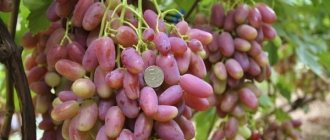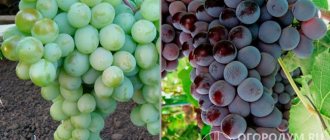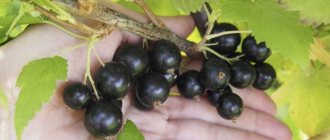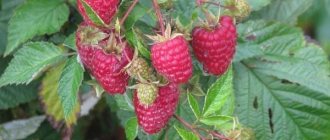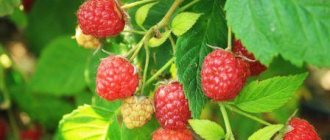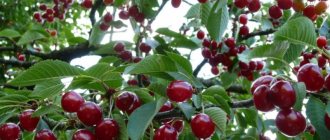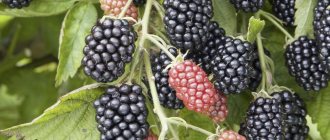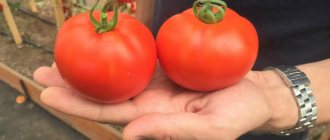Fruits in the northern regions
Characteristics:
| Pink grapes | |
| general characteristics | Varieties of universal use, vigorous growing |
| Ripening period | Growing season 90 - 160 days |
| Taste | 7.1 points (out of 10) |
| Weight | Berries from 3 to 6g, bunch 0.2-2 kg |
| Fruiting | Self-pollinating, produces bisexual flowers |
| Winter hardiness | from minus 23 to minus 30°C depending on the variety |
| Pests and diseases | Resistant to mildew, gray rot and oidium |
- Pink grape varieties are most in demand among gardeners and winegrowers in all regions. The main reason is high technical characteristics, high yields even in the northern regions.
- Pink grapes have the highest sugar content: from 23% , excellent taste. In 80% of varieties, bisexual flowers bloom, which completely solves the problem of pollination.
- Compared to other species, the best fruiting percentage is up to 1.7. The berries are very large, from 3 cm in length and from 2 cm in width, sweet and juicy.
- Pink varieties are resistant to the most common diseases and pests that can completely destroy vineyards.
Types of pink grapes include varieties suitable for cultivation in northern regions.
Photo: sipsiphooraysite.files.wordpress.com The author of the video talks about the features of the Gurzufsky variety and notes the unusual taste of the berries:
Very early varieties of table grapes. Description and photos of 14 varieties
Dear friends, today I continue the topic of grapes and we will talk about very early varieties. As in the previous article, there will be a photo of each variety and a short description. Despite the small information, it will include the most basic characteristics, which will help you decide on the variety that you want to plant on your site. Once you select it, you can find more extensive information about it on the Internet if you need it.
I did not set myself the task of giving each grape a complete description. My goal was to introduce you to a wide variety of very early ripening grape varieties. Today I have Laura growing on my plot of these varieties, and in the fall I dream of buying and planting Viking.
Very early ripening grape varieties
Such grapes can and should be grown in the northern regions. Even if it gets cold already in September, it is quite possible to harvest a good harvest when you have four warm months left. Why four, you ask. Yes, because from the moment the first leaf appears until the berries are completely ripe, about 4 months pass. The ripening time for very early varieties is 90-105 days. In Ukraine it falls at the beginning or end of August. Although during very hot summers the first harvest can be obtained at the end of July.
First-Called
The variety is self-pollinating. The average weight of a bunch is 700-1000 g, the color of the berries is amber, can withstand frost down to -23º, the weight of one berry is 10-12 g. Resistant to gray rot and mildew, but susceptible to powdery mildew.
Viking
On average, a bunch weighs 600 g, the color of the berries is blue, can withstand frost down to -21º, the length and width of the berries are 34x22 mm. The grapes are self-pollinating and not susceptible to peas. The taste has notes of prunes, and some winegrowers say that it is similar to the taste of cherries.
Long awaited
The grapes are self-pollinating. The weight of the bunch is 700-1500 g, the color is yellow, frost resistance is up to -23º, the berry weighs 10-12 g. It cracks badly during rain, but is little susceptible to attack by wasps. It ripens even on few sunny days, so it is perfect for northern regions.
Sphinx
The variety is self-pollinating. The bunches weigh about 600 g, the blue berries are 30x28 mm. Frost resistance down to -23º. Resistance to mildew and oidium is average. Undemanding to soil, does not like strong winds and drafts. Not susceptible to peas. The taste is not very sweet.
Zarnitsa
The average weight of a bunch is 700-1500 g, berries - 10-12 g. The skin is amber-yellow. Withstands short-term frosts down to -23º. They are not damaged by wasps. When overripe, the variety quickly becomes raisinized.
Laura
The mass of the bunch is 1000 g, a large cluster with large fleshy berries is 7-10 g, the taste and density are somewhat reminiscent of a plum. In a temperate climate, this early variety can grow and bear fruit with natural moisture; in the southern regions, watering is required. It is resistant to many diseases, but it has weak resistance to oidium and needs spraying.
This grape is loved by a large number of insects: leaf rollers, grape mites, weevils and so on. Mice can chew on the bark, so sleeves should be wrapped in winter. Withstands frosts down to -23º. Disadvantages include an increased love of wasps and peas.
Muscat delight
The mass of the brush is from 800 to 2000 g, and the berries are 10-12 g. The color of the peel is white-yellow with a slight tan when exposed to sunlight. Frosts down to -25º do not harm it. This variety easily tolerates drought. The leaves are often affected by phylloxera, and the grapes are moderately resistant to other diseases. Feels good in the northern regions. It grows well on arches and arbors. Often affected by grape aphids. After ripening, the fruits can remain on the vine for another 1.5 months without any loss.
Timur
The Timur variety today has two subspecies: pink and white. Because pink grapes ripen later and are less productive and tasty, they are not as popular as white grapes. The weight of a bunch of white grapes is 400-600 g, and the berries are 6-8 g. The pink variety has a bunch weight of up to 800 g, and fruits of 9-10 g. Frost resistance is up to -25º, both varieties are resistant to mildew and oidium, but are damaged by grape mites. They also grow well in any soil, but in heavy and wet soils their taste changes, acquiring a herbaceous-tart taste.
Ruta
Vigorous grapes with weak development of stepsons. The berries are very large, from 8 to 15 g, and the cluster itself weighs 400-800 g. The peel of this early variety is pink. The taste is sweet with a nutmeg aroma, and sometimes with a slight cherry flavor. The peculiarity of this grape is that the ripened bunches can hang on the bush for a long time without losing their properties and taste. The maximum temperature this variety can withstand is 20-22º. High resistance to diseases and to such phenomena as burning.
Super Extra
Another name for this grape is Citrine. It has such a fast ripening time that it ripens well and shades. Therefore, this variety is ideal for growing in northern regions where the climate is cool and there are few sunny days. The mass of the brush is from 500 to 1500 g, and the berries are 7-10 g. The peel is yellow. Withstands temperatures down to -25º. It has good resistance to fungal diseases, but still needs treatment, as it can be affected by phylloxera. In addition, protection from wasps is necessary.
Russian early
The second name of this variety is Sweetie. It is cold-resistant, withstands frosts down to -24º. The grapes are very early, so the harvest can be harvested at the end of July. Disease resistance is average. It is often attacked by wasps and pests. It needs good watering, otherwise the fruits will break in rainy weather. The weight of the brush is from 200 to 600 g, the berries are 4-6 g. The taste is slightly sour. Suitable for growing on gazebos and arches. The disadvantages include the fact that the first three years it has quite low yields.
Olympics
This is the earliest of all varieties, quite unpretentious to weather conditions, resistant to many diseases, and can withstand frosts down to -25º. Very tasty grapes, but the berries are small, only 2.5 g, and the bunch is 200 g. The variety is susceptible to peas. Another disadvantage is cracking during rains.
Dunav
Self-pollinating variety, cluster weight from 500 to 1500 g, berries weigh from 8 to 15 g. The frost resistance of the grapes is low, only -18º. Reacts to fungal diseases and is susceptible to insect attack. Does not tolerate excess moisture well. Taste with a nutmeg tint.
Elegant
The weight of the bunch is 300-400 g, the berries are up to 7 g. The color of the peel is amber. The grapes are completely unpretentious, adapt to any pruning, tolerate overload and do not require special care, they can even do without fertilizing. The only thing is that he does not like water getting on the leaves, which for this reason can become covered with brown spots. If improperly watered, mold can form on the trunks.
Drought-resistant, but when watered it gives a better harvest, frost resistance down to -25º. It resists diseases quite well, but is damaged by grape pests. A wonderful variety for those who can only devote attention to it for the weekend.
These are very early varieties of table grapes, absolutely each of them has its own pros and cons, which variety to choose is up to you. Good luck!
I wish everyone happiness, Natalia Murga
Antoshka (3.5 years old) was visiting and saw how a vase of fruit was placed on the table, among which were black (dark varieties) grapes. He ran up to the children (of other guests) and said: “Let’s go quickly, my God, something happened... the grapes turned black.”
My dear readers, if you liked the article, please leave your review. Your opinion is very important to make the blog interesting and useful.
Give your friends the opportunity to read this article too. All you need to do is click on the social media buttons and share information with them.
hobby-house.com
Propagate by cuttings and layering
| Cuttings Stages:
| |
| Layerings Stages:
|
Grapes Original: pink, black
According to some reports, approximately 2 thousand different varieties of grapes are grown in Russia alone. Ordinary amateur gardeners have not even heard of many of them, but the “Original” variety is probably familiar to many of them. This grape has an amazing color, unique taste and aroma. The “Original” grapes are not only tasty, but also very productive. By planting just one bush of this plant, you can feed your whole family with wonderful berries. You can learn about the characteristics, advantages and features of the “Original” variety, as well as how to grow it on your own plot, from our article. Surely, the information offered will be of interest to both experienced and novice winegrowers.
Description of the variety
There is no need to speak unequivocally about the “Original” grapes, since this variety exists in 3 different variations, which depend, first of all, on the color of the berries. Thus, the following types of “Original” are distinguished:
- Pink grapes. In the sun it can take on a purple color. This type of grape is shown in the photo above.
- A species with blue-black colored fruits. In bright sunlight, these berries can acquire a reddish tint.
- The berries of the white “Original” exhibit a greenish tint when exposed to sunlight. This type of grape can be seen in the photo below:
Having studied the variety of colors and shades, you understand that this grape got its name for a reason. It is truly original and can please everyone.
Variety selection
Before studying the “Original” grapes, description of the variety, photos and reviews about it, you need to know its origin, because the qualities of the ancestors largely affected the characteristics of the grapes.
The “Original” grape variety cannot be called a new product: it was bred 30 years ago at the Odessa Institute named after. V.E. Tairova. To create this crop, breeders crossed the Datier de Saint-Valier variety and Damask rose. As a result of crossing, a very interesting variety “Original” with excellent characteristics was obtained.
Productivity
The description of the “Original” grapes is similar for all types, with different colors of the fruit. Thus, the average duration of harvest ripening is 140 days. Most of the shoots on the bush are fruit-bearing, which allows for high fruit yields. For example, with industrial cultivation it is possible to collect approximately 100 kg/ha of berries. On private farmsteads, depending on specific conditions, the yield can range from 40 to 100 kg/bush. Read also: Monarch grapes
Description of berries
The “Original” berries of various colors are quite large: their length is 3 cm, diameter is 2 cm. The shape of the grapes is elongated, pointed downwards. On average, each berry weighs 5-7 kg, but there are also specimens weighing 10-12 g. The taste of the grapes is largely determined by the level of acidity and percentage of sugar. Thus, of the three types of “Original”, the most sour is the white variety. The acidity of its fruits is about 8 g/l, while other types of “Original” contain only 6 g/l. The sugar content of berries of all types varies from 15 to 21% depending on growing conditions.
The grape pulp is juicy and does not have a strong aroma. In some sources you can find information that it becomes slightly watery when the clusters are left on the bush for a long time after ripening.
The skin of the berries is very thin and delicate. It is barely noticeable when biting into a grape. There are seeds inside the fruit: literally 1-2 seeds in each berry.
Ripe grapes of the “Original” variety can be stored for as long as possible in favorable conditions, but they must be transported very carefully, since large berries do not adhere well to the stalk.
Important! Original grapes can be stored in a cool place until December-January.
To confirm the description of the “Original” variety, a photo of pink grapes is given below. It clearly shows the unique color, size of the berries, and shape of the bunch:
Description of the bush
The “Original” variety bush can become a real decoration of the garden. The plant is up to 3 m high, very spreading and lush. Its leaves are strongly dissected, consist of 5 lobes, and have some drooping. Clusters of uniquely colored berries are a great addition to juicy, fresh greens.
Description of the bunches
The "Original" grapes have a conical shape. Their weight varies from 600 g to 2 kg. Of the three types of grapes, the smallest bunches are the black “Original”. The berries on the clusters are arranged loosely or moderately tightly, which gives them a certain gracefulness.
Resistance to external factors
The “Original” variety is zoned for the Odessa region. This is due, first of all, to the heat-loving nature of the crop and the low level of frost resistance. Thus, a vineyard can successfully withstand frosts down to -21C, provided it is properly covered for the winter. Taking these features into account, the variety can be grown even in central Russia.
Diseases and pests
| Mildew Control measures:
| |
| Grape itch Control measures:
|
Advantages and disadvantages
When deciding to start growing “super extra” grapes, you should familiarize yourself in advance with the list of its positive and negative characteristics.
The main advantages of the variety for gardeners and winegrowers include:
- Large fruit.
- Resistant to frost and other adverse weather conditions.
- Good transportability and keeping quality.
- Abundant yield.
- Immunity to diseases characteristic of the culture.
Also, the indisputable advantage of the variety is that the berries on the bushes ripen evenly and have a pleasant taste.
The “super extra” has few disadvantages, but there are still some disadvantages:
- The probability of the formation of berries of different sizes on a bunch.
- Dense and tough skin.
- Tendency to phylloxera.
In addition, the bushes need timely pruning, aimed primarily at normalizing the yield. Otherwise, not only the quality of the berries deteriorates, but also their ripening period increases.
Reviews from gardeners
Arkady Golubev
5.09 cut off the signal on the Minsk Pink. The color is beautiful, dark pink, the berry is slightly larger than that of Sharov’s Riddle.
Source: forum.vinograd7.ru
Alexander-zelenograd, Zelenograd
Today I tried a berry from the Svenson Red signal box. I was shocked by the pineapple aroma and sugar content of 19%. Very pleasant variety! The berries themselves are large, pink-lilac in color.
Source: forum.vinograd.info
Early and late pink grape varieties
On a summer cottage you can grow not only apples and pears, but also grapes. Pay attention to pink grape varieties: they have advantages over white and dark varieties and have a wonderful mild taste.
The property common to all pink grapes is moderate sweetness and varied shape. They are not cloyingly sweet, but not sour either, they have different degrees of color, from pale pink to bright purple and even red, as well as different ripening times.
Pink grape varieties delight with a sweet taste and large berries.
Photo: Getty
Outside Russia, French, Italian, and Central Asian rosé varieties are especially respected: Merlot, Cabernet, Sibouren, Syrah, Taifi. But Russian, or rather, Soviet viticulture has something to be proud of. In Russia, Ukraine, and Moldova, original crops are grown that are not inferior to foreign ones.
The following must be included in the description of varieties of pink grapes of domestic origin.
- Gurzufsky pink is an early variety with berries of lilac, almost black color. Frost-resistant, sweet, with a pronounced nutmeg taste, very prolific. Good for both winemaking and food.
- “Original” is a variety that holds the record for fertility. Gardeners can remove about 90 kg of berries from the bush from the second year of cultivation. It is distinguished by a special conical shape of oblong fruits, is insensitive to pests, and does not tolerate transportation well.
- The “Anyuta” variety produces a huge bunch weighing up to 2 kg. Fleshy, nutmeg-honey-tasting, the berries are shaped like an egg.
These varieties are considered medium-late in ripening time. They take root well in a summer cottage and do not require careful care.
A short ripening period is an undoubted advantage of grapes planted on a summer cottage. Summer in the central and northern parts of Russia is short, and rapid ripening, of course, is welcomed by gardeners.
Here is a list of the most popular early varieties.
- “Pink haze” is a table variety, a close relative of sultanas. The berries look like balls of pale pink color. It is characterized by frost resistance, large clusters up to 1.5 kg, and high yield. Unsuitable for making wine.
- Pink peach has huge cluster sizes. This is a dessert variety with a characteristic aftertaste: large 14-gram berries leave a strawberry flavor on the tongue. It takes root well in northern regions and quickly begins to bear fruit.
- “Transfiguration” is a hybrid variety. Its clusters reach 1.5 kg, and the sweet 18-gram berries are tasty and juicy. It is frost-resistant and unpretentious, like many hybrids.
- The “Angelica” or “Xenia” variety has pleasant-tasting berries, withstands frost, and produces large clusters weighing up to 2 kg.
If you look at the photo for the description of early pink grape varieties, it becomes clear that the external difference between early, middle and mid-late varieties is insignificant.
Pink grapes delight the tongue with a pleasant sweetness, and the eyes with large berries of regular and original shape. Grape bushes planted in a garden plot will decorate it, and the fruits will give gastronomic pleasure.
Also interesting: white grape varieties
May 26, 2017
www.wday.ru
Comparison with analogues
“Super Extra” is far from the only table grape variety with early ripening. However, thanks to its characteristics, it can compete with other varieties.
| Sign | Variety | ||||
| Super extra | Karmacode | Russian Korinka | New gift to Zaporozhye | Blagovest | |
| Ripening period | 95-105 days | 110-125 days | 110-115 days | 110-125 days | 110-115 days |
| Frost resistance | Up to -25 °C | Up to -22 °C | Up to -22…-28 °C | Up to -24 °C | Up to -23 °C |
| Yield per bush | Up to 25 kg | About 25 kg | Up to 12 kg | Up to 30 kg | 6-8 kg |
| Bunches | 500-800 g | 300-500 g | 180-200 g | From 800 g to 1.1 kg | From 900 g to 1.2 kg |
| Taste | Simple, moderately sweet | Tart with a slight nutmeg aroma | Rich, without extraneous flavors | Sweetish with apple aftertaste | Sweet with notes of duchess and aroma of nutmeg |
| Color | Green-yellow with amber tint | Red-violet | Golden with soft pink blush | Greenish white | Green with a yellowish tint and an amber tan |
| Disease resistance | Average | Average | Average | High | Average |
| Shelf life | A few months | Up to 3 months | Until autumn on the bush | Up to 3 months | A few months |
| Sugar content | 17,40% | 16-22% | 22-23% | 16-19% | Up to 22% |
| Acidity | 6.1 g/l | 9 g/l | 5-6 g/l | 5-6 g/l | About 8 g/l |
Useful properties and applications
Grapes are a source of vitamins, macro- and microelements necessary for the human body. The berries contain vitamins: PP, C, A, E, B1, B2, B5, B6, 9, H, K, malic, citric, tartaric and succinic acids, pectin, flavonoids, potassium, phosphorus, silicon, boron, iron, vanadium, iodine, cobalt, copper, manganese, lithium.
| Benefits of grapes | ||
| For men | For women | For children |
| Helps prevent the risk of developing cardiovascular disease | Helps maintain skin elasticity and has anti-aging properties | Helps strengthen the immune system |
| Helps normalize sleep | Significantly reduces the damage caused by ultraviolet rays, helps avoid the risk of developing melanoma | Normalizes digestion, helps get rid of constipation and gas formation |
| Capable of destroying cancer cells in the prostate gland, which is why it is considered an antitumor product | Increases hemoglobin levels, which is extremely important during pregnancy | Stimulates not only physical, but also mental activity |
| Supports potency | Helps normalize estrogen levels, which is especially important for women during menopause | Improves hematopoietic processes |
Like the fruits of other table varieties, “super extra” berries are primarily consumed fresh. However, due to their fairly high sugar content, they can be used to make high-quality juices, compotes and wines.
